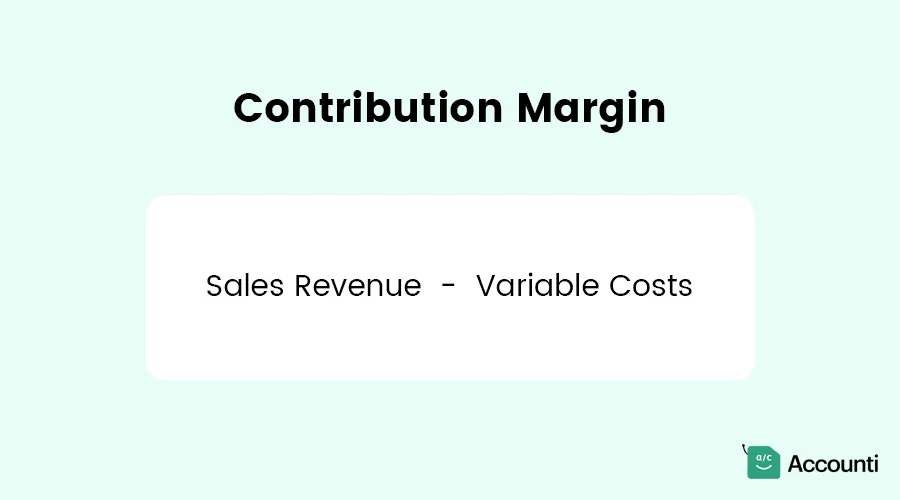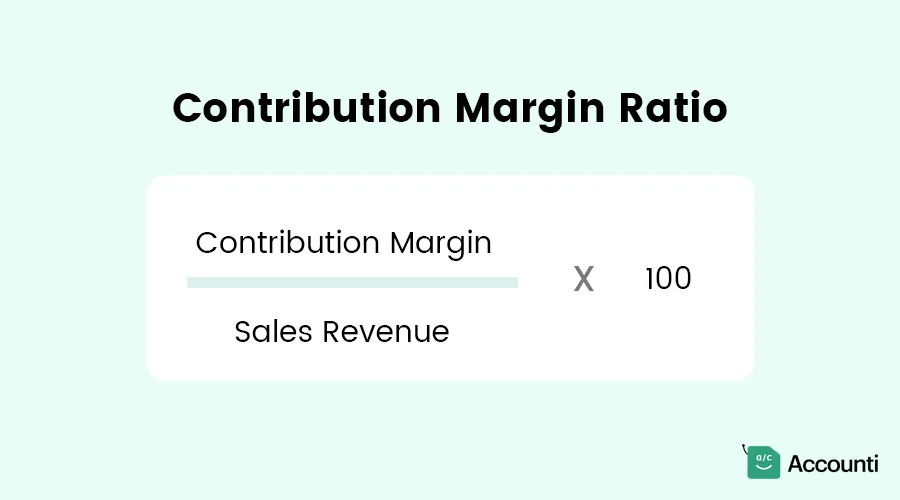
How to Calculate Contribution Margin with Example
Understanding your company's financial metrics is crucial for success in a competitive business landscape.
One of the most important yet often misunderstood concepts is contribution margin.
Whether you're a seasoned entrepreneur or just starting out, mastering this financial tool can give you valuable insights into your business's profitability and help drive informed decision-making.
In this comprehensive guide, we'll dive deep into the world of contribution margin, exploring what it is, how to calculate it, and why it matters for your business.
What is the contribution margin?
Contribution margin is a crucial financial metric that helps businesses understand the profitability of their products or services. It represents the portion of sales revenue that remains after subtracting variable costs. This leftover amount "contributes" to covering fixed costs and, ultimately, to the company's profit.
In simpler terms, contribution margin shows how much of each sale is available to cover fixed expenses and generate profit. It's a powerful tool for decision-making, particularly when it comes to pricing, production, and sales strategies.
The contribution margin formula
Calculating the contribution margin is straightforward. The basic formula is:
 Contribution Margin = Sales Revenue - Variable Costs
Contribution Margin = Sales Revenue - Variable Costs
This formula can be applied to a single unit, a product line, or the entire company. Let's break it down further:
- Sales Revenue: The total amount earned from sales before any deductions
- Variable Costs: Expenses that change in proportion to production or sales volume (e.g., raw materials, direct labor, sales commissions)
Sample contribution margin Example
Let's illustrate this with a simple example:
Suppose you run a small bakery that sells artisanal bread. Each loaf sells for $5 (sales revenue per unit). The variable costs for ingredients and packaging are $2 per loaf.
Using the contribution margin formula:
Contribution Margin = $5 - $2 = $3 per loaf
This means that for every loaf of bread sold, $3 contributes to covering fixed costs (like rent and utilities) and profit.
The contribution margin ratio
The contribution margin ratio expresses the contribution margin as a percentage of sales revenue. It's calculated using the following formula:
 Contribution Margin Ratio = (Contribution Margin / Sales Revenue) x 100
Contribution Margin Ratio = (Contribution Margin / Sales Revenue) x 100
Using our bakery example:
Contribution Margin Ratio = ($3 / $5) x 100 = 60%
This means that 60% of each sale contributes to fixed costs and profit.
Types of Contribution Margin
Contribution margin per unit
This is the contribution margin for a single unit of a product or service. It's calculated by subtracting the variable cost per unit from the selling price per unit.
Total contribution margin
The total contribution margin is calculated for the entire company or a specific product line. It's the total sales revenue minus total variable costs.
Contribution margin ratio
As we've seen, this is the contribution margin expressed as a percentage of sales revenue.
How to Improve Contribution Margin
Improving your contribution margin can significantly boost your business's profitability. Here are three main strategies:
Reducing variable costs
By finding ways to lower the costs directly associated with producing your goods or services, you can increase your contribution margin. This might involve:
- Negotiating better rates with suppliers
- Improving production efficiency
- Reducing waste in the production process
Increasing sales price
If your market can bear it, increasing your selling price will directly improve your contribution margin. However, be cautious as this may affect demand.
Improving sales volume
While this doesn't directly increase the contribution margin per unit, it can increase the total contribution margin. Strategies might include:
- Expanding your market reach
- Improving marketing efforts
- Offering volume discounts to encourage larger purchases
Contribution margin vs gross profit margin
While both metrics are used to assess profitability, they differ in what they measure:
- Contribution Margin: Sales Revenue - Variable Costs
- Gross Profit Margin: Sales Revenue - Cost of Goods Sold (COGS)
The main difference is that COGS includes both variable and fixed production costs, while contribution margin only considers variable costs.
Example: Let's say our bakery sells 1000 loaves a month. Each loaf sells for $5, has variable costs of $2, and there's a fixed cost of $1000 for the oven's depreciation.
Contribution Margin: ($5 - $2) x 1000 = $3000
Gross Profit: ($5 x 1000) - ($2 x 1000 + $1000) = $2000
Fixed Cost vs. Variable Cost
Understanding the difference between fixed and variable costs is crucial for calculating contribution margin:
- Fixed Costs: Expenses that remain constant regardless of production volume (e.g., rent, insurance)
- Variable Costs: Expenses that change in proportion to production volume (e.g., raw materials, direct labor)
Example: For our bakery:
- Fixed Cost: Monthly rent of $2000
- Variable Cost: $2 per loaf for ingredients and packaging
If we produce 1000 loaves, total variable costs are $2000, while fixed costs remain at $2000 regardless of production volume.
Business Benefits: Why do you need a contribution margin?
Contribution margin provides several key benefits for businesses:
- Pricing decisions: It helps determine the lowest price you can charge without losing money.
- Product mix optimization: You can focus on products with higher contribution margins.
- Break-even analysis: It's essential for calculating the break-even point.
- Cost control: Identifying products with low contribution margins can guide cost-cutting efforts.
- Sales strategies: It can inform decisions about sales promotions and discounts.
Uses of Contribution Margin
Contribution margin is a versatile tool with multiple applications:
- Break-even analysis: Determine how many units you need to sell to cover all costs.
- Product line decisions: Identify which products are most profitable.
- Make or buy decisions: Evaluate whether it's more cost-effective to produce components in-house or purchase them.
- Accepting special orders: Assess whether one-time orders at a discounted price are profitable.
- Shutdown analysis: Determine at what point it's better to temporarily cease operations.
Contribution Margin Analysis
Contribution margin analysis involves examining the contribution margins of different products, services, or departments to make informed business decisions. This analysis can reveal:
- Which products or services are most profitable
- How changes in sales mix affect overall profitability
- The impact of price changes on profitability
- Opportunities for cost reduction
To conduct a contribution margin analysis:
- Calculate the contribution margin for each product or service
- Compare contribution margins across different offerings
- Analyze trends over time
- Use the insights to inform strategic decisions
Common mistakes when using the Contribution Margin
While contribution margin is a powerful tool, it's important to avoid these common pitfalls:
-
Ignoring fixed costs: Remember, a positive contribution margin doesn't
necessarily mean profitability if fixed costs aren't covered.
-
Misclassifying costs: Ensure you're correctly distinguishing between fixed
and variable costs.
-
Overlooking non-financial factors: Don't make decisions solely based on
contribution margin. Consider factors like customer relationships and
long-term strategy.
-
Assuming linearity: The relationship between volume and costs may not always
be linear in reality.
-
Neglecting capacity constraints: High contribution margin products might not
be the best choice if they strain your production capacity.
-
Forgetting about quality: Don't sacrifice product quality in an attempt to
increase contribution margin.
-
Ignoring market factors: Remember that pricing decisions affect demand,
which in turn impacts your total contribution margin.
Conclusion
Understanding and effectively using contribution margin can significantly enhance your business decision-making process. By focusing on products or services with higher contribution margins, optimizing your pricing strategy, and continually seeking ways to reduce variable costs, you can improve your company's profitability. Remember, while contribution margin is a powerful tool, it should be used in conjunction with other financial metrics and business considerations for comprehensive analysis and strategy development.
FAQs
How Do You Calculate the Contribution Margin?
To calculate the contribution margin, subtract the variable costs from the sales revenue. The formula is Contribution Margin = Sales Revenue - Variable Costs. This can be calculated per unit, for a product line, or for the entire company.
How to calculate contribution percentage?
The contribution percentage, also known as the contribution margin ratio, is calculated by dividing the contribution margin by sales revenue and multiplying by 100. The formula is: Contribution Margin Ratio = (Contribution Margin / Sales Revenue) x 100.
What Is a Good Contribution Margin?
A "good" contribution margin varies by industry and business model. Generally, a higher contribution margin is better as it means more funds are available to cover fixed costs and generate profit. However, it's important to compare your contribution margin to industry benchmarks for a more accurate assessment.
What Is the Difference Between Contribution Margin and Profit Margin?
Contribution margin focuses on the profitability of individual products or services by considering only variable costs. Profit margin, on the other hand, takes into account all costs (both variable and fixed) and represents the overall profitability of the business. Contribution margin is used for internal decision-making, while profit margin is often used to assess the overall financial health of a company.
What is the formula for contribution margin in Excel?
In Excel, you can calculate the contribution margin using a simple formula. If sales revenue is in cell A1 and variable costs are in cell B1, the formula would be: =A1-B1. For the contribution margin ratio, the formula would be = (A1-B1)/A1. You can then format the cell as a percentage to display the contribution margin ratio.

 Rohit Kapoor
Rohit Kapoor

